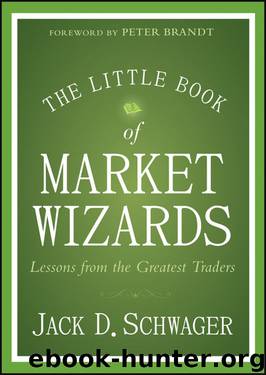The Little Book of Market Wizards: Lessons from the Greatest Traders by Jack D. Schwager

Author:Jack D. Schwager [Schwager, Jack D.]
Language: eng
Format: epub
ISBN: 9781118858646
Publisher: Wiley
Published: 2014-01-31T00:00:00+00:00
Warren Buffett
As a hobby, Greenblatt has taught a course in the Columbia Business School for many years. In our interview, Greenblatt related the advice he gave students when they asked him what to do with companies whose future earnings were very difficult to predict because of rapid technological changes, new products, or other factors. Greenblatt is a big fan of Warren Buffett and invoked a Buffett aphorism in advising his students how to handle such ambiguous investment situations. “I tell them to skip that company and find a company that they can analyze. It is very important to know what you don’t know. As Warren Buffett says, ‘There are no called strikes on Wall Street.’ You can watch as many pitches as you want and only swing when everything sets up your way.”
Claude Debussy said, “Music is the space between the notes.” One could also say that successful trading is the space between the trades. Just as the notes not played are important to music, the trades not taken are important to trading success. Kevin Daly, an equity trader I interviewed in Hedge Fund Market Wizards, provides a perfect example of this principle. Although, technically speaking, Daly is a long/short equity manager, his total short position is invariably very small—almost always measured in single-digit percentages of assets under management. So, in this sense, Daly is much closer to a long-only equity manager than to a long/short manager. Daly launched his fund in late 1999, only about a half-year before the major stock market top in early 2000. Clearly, this was an unpropitious staring point for a manager whose portfolio primarily consists of long equities. Yet, despite this unfavorable timing, at the time I interviewed Daly, he had managed to achieve a cumulative gross return of 872 percent during an 11-year period in which the Russell 2000 was up only 68 percent and the S&P 500 was actually down 9 percent.
How did Daly achieve such strong returns during a period of near flat stock prices, despite running a portfolio that was predominantly long? Part of the answer is that he was very good at picking stocks that outperformed the indexes. But perhaps the most important factor in explaining Daly’s outperformance is that he had the discipline to remain largely in cash during negative market environments, which allowed him to sidestep large drawdowns during two major bear markets. During a time span in which the S&P 500 witnessed two separate occasions where it lost nearly half its value, Daly’s largest peak-to-valley drawdown was only 10 percent. The key is that by avoiding large losses by not trading, Daly was able to increase his cumulative return tremendously. Achieving this result necessitated maintaining a very low exposure for much of the extended 2000–2002 bear market. Think of the patience that required. Daly’s patience and the trades that he did not take made all the difference.
Mark Weinstein, a trader I interviewed in Market Wizards, used an animal kingdom analogy to illustrate the link between patience
Download
This site does not store any files on its server. We only index and link to content provided by other sites. Please contact the content providers to delete copyright contents if any and email us, we'll remove relevant links or contents immediately.
Rich Dad Poor Dad by Robert T. Kiyosaki(6185)
Pioneering Portfolio Management by David F. Swensen(6083)
How To Win Friends and Influence People by Dale Carnegie(4341)
The Money Culture by Michael Lewis(3851)
The Dhandho Investor by Mohnish Pabrai(3566)
The Wisdom of Finance by Mihir Desai(3531)
Liar's Poker by Michael Lewis(3228)
The Intelligent Investor by Benjamin Graham Jason Zweig(2936)
The ONE Thing by Gary Keller(2922)
Mastering Bitcoin: Programming the Open Blockchain by Andreas M. Antonopoulos(2895)
Fooled by Randomness: The Hidden Role of Chance in Life and in the Markets by Nassim Nicholas Taleb(2868)
Rich Dad Poor Dad: What The Rich Teach Their Kids About Money - That The Poor And Middle Class Do Not! by Robert T. Kiyosaki(2836)
Investing For Dummies by Eric Tyson(2800)
How to Win Friends and Influence People by Dale Carnegie(2799)
How to Day Trade for a Living: Tools, Tactics, Money Management, Discipline and Trading Psychology by Andrew Aziz(2787)
Market Wizards by Jack D. Schwager(2545)
Zero Hour by Harry S. Dent Jr. & Andrew Pancholi(2537)
How to Pay Zero Taxes, 2018 by Jeff A. Schnepper(2503)
Rich Dad's Guide to Investing by Robert T. Kiyosaki(2412)
